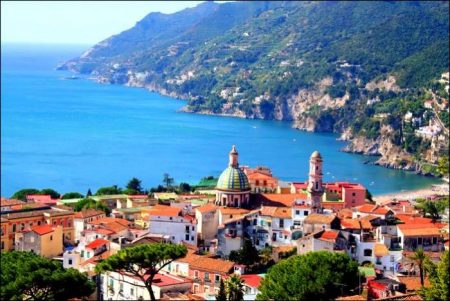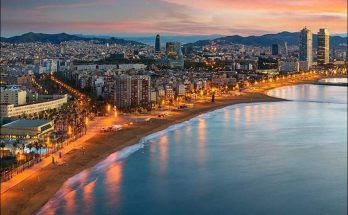The climate of Italy may be described as temperate, as the winter, owing to the low latitude, is not too severe and the summer is not too hot, owing to the wide expanse of sea around. At the same time the several provinces differ greatly in climate, as might be expected in a country extending through ten degrees of latitude, with the high land of the Alps at one end and dry Africa in the neighbourhood of the other.
We may divide Italy into four sections in regard to climate: 1st, Upper Italy as far as 45° 30′ N. lat., with a minimum temperature of 14° F., 2nd, Central Italy to 41° 30′, the region of olive, lemon and orange trees, where the winter is seldom severe, though snow falls as a rule on the mountains, with a minimum of 21.2 F., 3rd, Lower Italy to 39° N. lat. where the lowest is 26.6° F., and 4th, Sicily, where the temperature does not fall below the freezing point.
The Apennines have a great influence on the climate, as they keep off the north and north-east winds from the parts of the country lying to the west, so that the Adriatic coasts have more severe winters and hotter summers than the Tyrrhenian. The plain of Lombardy obviously depends on the Alps in regard to its climate, and in the sharper contrast between summer and winter it is stamped with a more continental character than any other part of Italy.
Observations on the temperature, the barometer, the rainfall, and the winds have been taken in various places since the beginning of the nineteenth century, especially at the observatories, but also occasionally by private persons. They were first organized and unified in 1866 when twenty-one stations for weather observations were established and placed in regular telegraphic communication with Florence, the then capital, so that it has become possible to make forecasts of the weather. This central institution was removed to Rome in 1880 after the transference of the capital, and united with the officio centrale mateorologico e geodinamico, the number of stations being at the same time doubled.
Weather, temperature, and rainfall are dependent on the winds. In Italy the north wind coming over the Apennines is called Tramontano. It is a cold wind bringing clear dry weather, but it is not liked in Southern Italy, as the temperature falls and people begin to freeze. Even in Naples thin ice is formed by the Tramontano in clear winter nights.
A north-east wind (Greco), the Bora of Dalmatia and Istria, is much dreaded; it frequently covers the Apennines with masses of snow in March or at the end of February, and this snow extends on the western slope of the range to Campania and the environs of Rome. This is unusual, as the Bora usually brings only a cold rain in these districts, and this the Italian of the south designates “neve,” and finds very unpleasant. The east wind is called Levante, and is a warm current.
For the south and south-east winds the designation Sirocco is used, to indicate a hot current of air, producing fatigue and sleepiness, which is much dreaded. The sky is cloudy, of a grey or yellow, or even of a red colour, the temperature is high, the force of the wind generally sufficient to raise great waves at sea.
On the east coast of Sicily the Sirocco is often accompanied on the north coast by a dampness in the air, without actual rain; it seems hot and dry, and if it succeeds in reaching Naples over the Tyrrhenian Sea comes as a sultry rainy wind, producing high waves on the Gulf, and often bringing violent rain or storms. The Sirocco is a frequent wind, setting in every month in Sicily, and lasting for weeks in October and November, while in the north-east of the Adriatic Sea it often blows for a third of the winter.
The west winds are called Libeccio, and are the prevailing winds in Sicily ( Palermo). A very peculiar phenomenon, perhaps reminding us of the “Sea-bear” of the German coasts, is the Marobbio of Sicily. It is a sudden gust of wind accompanied by an unusually violent disturbance of the sea, disappearing as quickly as it came. This may possibly be connected with local depressions of the atmosphere, which also influence the surface of the sea.
On the Ligurian coast, as in neighbouring Provence, prevails the Mistral (Maestro). This blows from the north or north-west, and is a wind of descent directed upon the Tyrrhenian Sea, which appears with great regularity at a certain time. Its principal haunt is the valley of the Rhone, but it occurs as far as the head of the Gulf of Genoa. The winds of the Lombard Lakes have special names, e.g. on Lago Maggiore the north-west wind is Mergozzo, the south-east Inverna, the east-south-east Marenco. On Lake Como the north is Tivano, the south Breva. These are for the most part mountain currents blowing in the direction of the lakes.
The prevailing directions of the wind in Italy are south in the winter, north in summer, east and west in spring and autumn. Change of wind is dependent on depressions and their displacement, and indeed eddies often occur over Liguria, the Tyrrhenian and Ionian Seas, either together or close upon one another. Over the plain of Upper Italy runs an atmospheric draught passage for the Atlantic cyclones leading from Brittany over Central France and the Southern Alps, and separating into three parts at the Adriatic, one arm turning south-east along the Apennines.
Eight times a year on an average storms traverse this route with a velocity of 250 miles an hour, under a mean barometric pressure of 29.4 inches. The summer is usually free from them. According to the chart of mean atmospheric pressures in the Mediterranean region given by Hann a depression located in the Ligurian Bay in December passes slowly in the spring over Corsica, Sardinia, and the Tyrrhenian Sea in a southeasterly direction towards the North African coast, reaching its maximum in July and August, and then commencing its return.
In general, as is natural, the mean temperature increases from north to south. The sharpest contrasts prevail in the plain of Lombardy, while the islands show a uniform climate. In Milan the average temperature in January is somewhat over 33° F., that of July 75°, about; for Rome the number is 45° and 76°, for Naples 46.8° and 74.9°, for Palermo 51.6° and 76.6°.
In Upper Italy the appearance of winter is like that in Central Europe; there is frost every year in Milan, and the snow often remains on the ground for a week or more. In the same way the Apennines of Bologna are covered almost every year with such deep snow that traffic on the railways is often interrupted. On the other hand, the summer is hot in the valley of the Po; the monthly averages for Milan in June, July, and August are nearly the same as those of Palermo, and on the Apennines a frightful drought prevails, so that the rivers are almost entirely dried up.
There and in Southern Italy the tree blossoms are often injured in March by sudden returns of cold, often accompanied by deep falls of snow, and the foreigner who has been enjoying warm or even hot days must take extra precautions against catching cold. In March there is, as a rule, the weather of a German April, sudden alternations of rain and blue sky, and as we call April “fickle,” so the Italians say “Marzo pazzo” (Mad March).
April and May are warm, beautiful months in Florence and Rome, further south May is often very hot, and every one in the towns who can do so tries to escape. The heat rises in Rome during July and August to 99° and 100°, as also in Naples, but there the sea always generates a cool and refreshing breeze towards evening. During the hot midday hours all life ceases in the streets and does not re-awaken till the cooling begins, when it goes on till late in the warm night.
Radiation of heat follows the intense absorption with some rapidity, and from half an hour to an hour after sunset a feeling of cold is experienced, in spite of the high temperature of the air. This is avoided as much as possible by the inhabitants as threatening infection of fever. Spring in Sicily, where the temperature never sinks below freezing point, begins in February.
The average temperature in Palermo for March is about the same as that in Naples for April, and in the hot months, especially July, occur maxima of 104°, with a mean temperature of 77° in July and August, As no rain falls during this time, all vegetation, with the exception of evergreens, dries up, for which reason the harvest takes place in June, and there is no resurrection of the vegetable world till the end of September, after the first rainfall. Malta possesses a very equable climate. Sardinia likewise shows but slight difference between the mean temperatures of summer and winter.
Local conditions often require us to make exceptions from these general rules. The southern slope of the Alps has a milder average climate than the plain of the Po, in the narrow valleys open to the south and protected against the north wind. From this result, on the one hand, the fact that southern plants such as the lemon and the olive can winter in the open air, and on the other the use of these districts as winter resorts for invalids from the north.
The same holds for the corresponding slopes of the Ligurian Apennines which, turned to the south through several degrees of longitude and lying close upon the sea, show yet more favourable, conditions, the mean temperature in winter being between 48° and 50°, some 10° higher than at Milan. For the like cause Catania is warmer than Palermo, which opens northward to the sea, and on this account the summer heat in Palermo is not so unendurable as in Catania and Syracuse, while the winter temperatures are nearly the same.
Visits: 111



